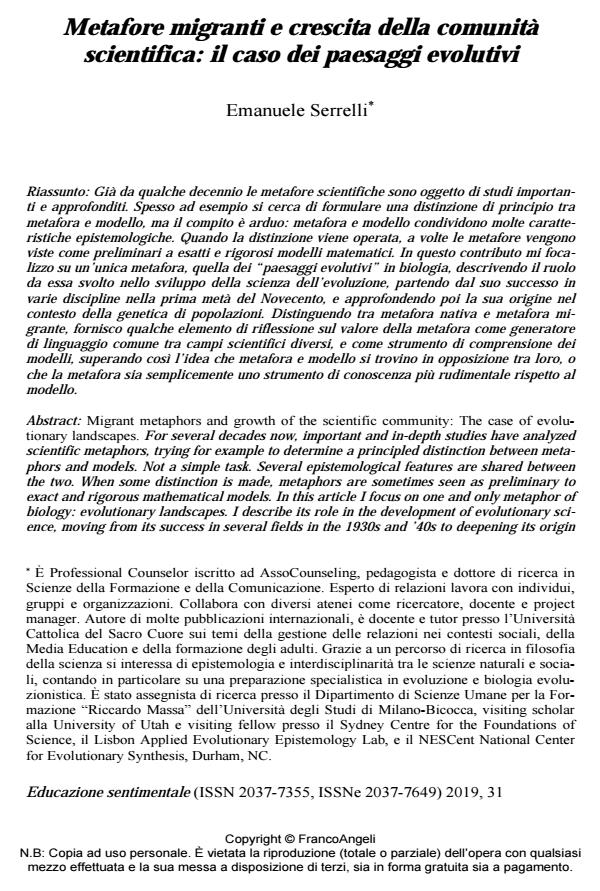Metafore migranti e crescita della comunità scientifica: il caso dei paesaggi evolutivi
Journal title EDUCAZIONE SENTIMENTALE
Author/s Emanuele Serrelli
Publishing Year 2019 Issue 2019/31 Language Italian
Pages 14 P. 115-128 File size 206 KB
DOI 10.3280/EDS2019-031010
DOI is like a bar code for intellectual property: to have more infomation
click here
Below, you can see the article first page
If you want to buy this article in PDF format, you can do it, following the instructions to buy download credits

FrancoAngeli is member of Publishers International Linking Association, Inc (PILA), a not-for-profit association which run the CrossRef service enabling links to and from online scholarly content.
Migrant metaphors and growth of the scientific community: The case of evolutionary land-scapes. For several decades now, important and in-depth studies have analyzed scientific metaphors, trying for example to determine a principled distinction between metaphors and models. Not a simple task. Several epistemological features are shared between the two. When some distinction is made, metaphors are sometimes seen as preliminary to exact and rigorous mathematical models. In this article I focus on one and only metaphor of biology: evolutionary landscapes. I describe its role in the development of evolutionary science, mov-ing from its success in several fields in the 1930s and ’40s to deepening its origin in the con-text of population genetics. By drawing a distinction between native and migrant metaphor, I provide some elements of reflection on the value of metaphor as a generator of common lan-guage between separated scientific fields, and as a tool for understanding models. In this way I also suggest overcoming the model vs. metaphor opposition, especially the idea that meta-phors are a more rudimental knowledge tool than models.
Keywords: Model, metaphor, scientific language, evolution, adaptive landscape.
- Black M. (1962). Models and Metaphor: Studies in Language and Philosophy. Ithaca: Cornell University Press.
- Calcott B. (2008). Assessing the fitness landscape revolution. Biology and Philosophy, 23(5): 639-657.
- Dawkins R. (1996). Climbing Mount Improbable. New York: W.W. Norton & Company. Trad. it. Alla conquista del Monte Improbabile. Milano: Mondadori, 1997.
- Darwin C.R. (1859). On the origin of species by means of natural selection. London: John Murray, sesta edizione 1872. Trad. it. L’origine delle specie. Roma: Newton Compton, 2000.
- Dobzhansky T. (1937). Genetics and the Origin of Species. New York: Columbia University Press, 3rd ed., 1951.
- Fusco G., Carrer R., Serrelli E. (2014). The landscape metaphor in development. In: A. Minelli, T. Pradeu, eds., Towards a theory of development. Oxfod: Oxford University Press, pp. 114-128 -- [http://hdl.handle.net/10281/48518].
- Gadamer H.G. (1975). Truth and Method. Journal of Aesthetics and Art Criticism, 36(4): 487-490.
- Gavrilets S. (2004). Fitness Landscapes and the Origin of Species. Princeton: Princeton University Press.
- Hesse M. (1966). Models and Analogies in Science. Notre Dame: University of Notre Dame Press.
- Hesse M. (1980). The explanatory function of metaphor. In: M. Hesse, Revolutions and Reconstructions in the Philosophy of Science. Bloomington: Indiana University Press, pp. 111-124.
- Hesse M. (1987). Tropical talk: the myth of the literal. The Aristotelian Society, 61(supplement): 297-310.
- Hesse M. (1993). Models, metaphors and truth. In: F.R. Ankersmit, J.J.A. Mooij, eds., Knowledge and Language. vol. 3. Dordrecht: Kluwer Academic Publishers.
- Huxley J.S. (1942). Evolution, The Modern Synthesis. London: Allen and Unwin.
- Kaplan J.M. (2008). The end of the adaptive landscape metaphor? Biology and Philosophy 23(5): 625-638.
- Keller E.F. (2002). Making Sense of Life: Explaining Biological Development With Models, Metaphors, And Machines. Cambridge-London: Harvard University Press.
- Mayr E. (1959). Where are we? Cold Spring Harbor Symposia on Quantitative Biology, 24: 1-14.
- Mayr E. (1973). The recent historiography of genetics. Journal of the History of Biology, 6: 125-154.
- Mayr E. (1980). Prologue: Some thoughts on the history of the evolutionary synthesis. In E. Mayr, W.B. Provine, eds. (1980), pp. 1-48.
- Mayr E., Provine W.B., eds. (1980). The Evolutionary Synthesis: Perspectives on the Unification of Biology. Cambridge & London: Harvard University Press.
- Monod J. (1970). Le Hasard et la nécessité. Paris: Le Seuil. Tr. Chance and Necessity: An Essay on the Natural Philosophy of Modern Biology. New York: Alfred A. Knopf, 1971.
- Pigliucci M. (2008a). Sewall Wright’s adaptive landscapes: 1932 vs. 1988. Biology and Philosophy 23: 591-603.
- Pigliucci M., Kaplan J. (2006). Making Sense of Evolution. Chicago: University of Chicago Press.
- Provine W.B. (1980). Epilogue. In: E. Mayr, W. Provin, eds. The Evolutionary Synthesis, cit., pp. 399-411.
- Serrelli E. (2011). Adaptive landscapes: a case study of metaphors, models, and synthesis in evolutionary biology. PhD Dissertation in Educational and Communicational Sciences, Human Sciences Doctorate School, University of Milano Bicocca, Milan, Italy. -- [http://hdl.handle.net/10281/19338].
- Serrelli E. (2015). Visualizing macroevolution: from adaptive landscapes to compositions of multiple spaces. In: E. Serrelli, N. Gontier, eds., Macroevolution: explanation, interpretation and evidence. Interdisciplinary Evolution Research series, Springer, pp. 113-162. -- [http://hdl.handle.net/ 10281/49988]. DOI: 10.1007/978-3-319-15045-1_4
- Simpson G.G. (1944). Tempo and Mode in Evolution. New York: Columbia University Press.
- Wright S. (1932). The roles of mutation, inbreeding, crossbreeding and selection in evolution. In: Proc of the 6th International Congress of Genetics, Vol. 1: 356-366.
Emanuele Serrelli, Metafore migranti e crescita della comunità scientifica: il caso dei paesaggi evolutivi in "EDUCAZIONE SENTIMENTALE" 31/2019, pp 115-128, DOI: 10.3280/EDS2019-031010